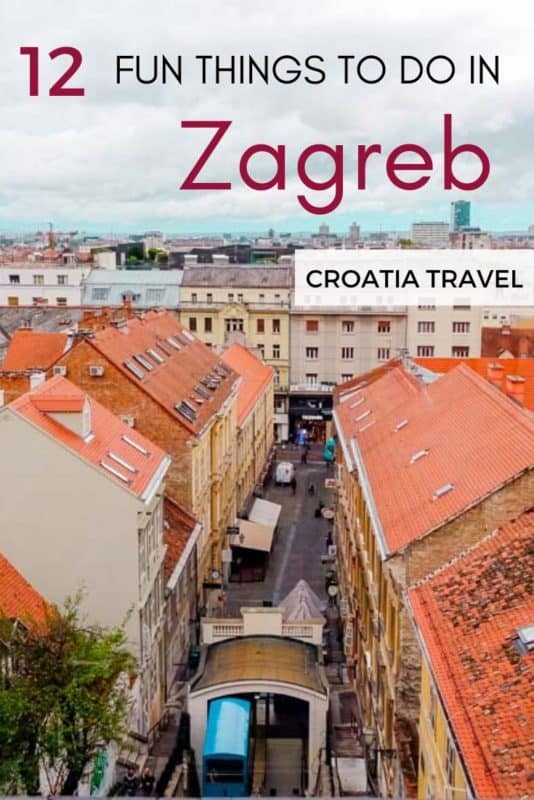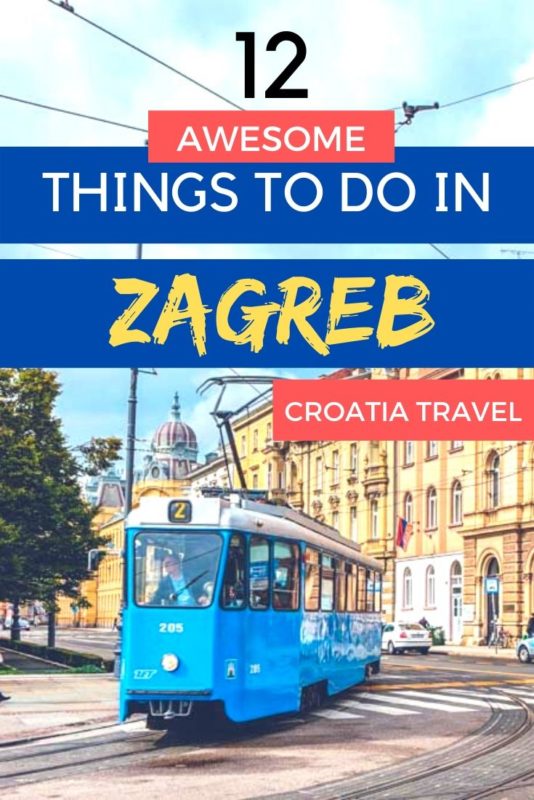What to Do in Zagreb, Croatia
Croatia’s capital Zagreb is not as a popular destination for travelers as Dubrovnik, Split, Plitvice National Park, or its islands. Zagreb is no less than those destinations and should definitely be on your bucket list. Moreover, it’s one of the cheapest cities in the country! Usually, the capital is the most expensive one, but here, its the opposite.
What to do in Zagreb? Zagreb sightseeing boasts with its interesting culture, historic sights which date back to the Roman times, beautiful cathedrals, world-known Museum of Broken Relationships to keep you intrigued and awed, and a wide choice of day trips from Zagreb to charming Croatian towns or even in neighboring Slovenia. Most of the city’s attractions are free, and some require a small fee to enter.
The city is divided into two parts – Upper and Lower town – and exploring both parts is not hard at all. Zagreb attractions are well connected to each other, so you can easily walk around the city without taking any public transportation.
How to Get to Zagreb
Getting to Zagreb from different cities in Europe is not a big deal. There are plenty of airlines flying directly from Germany, Spain, Belgium, UK, Poland, and many more. Unfortunately, the budget airlines like Wizzair or Ryanair are not flying to the Croatian Capital.
If you are traveling from any other city of Croatia to Zagreb, it’s even easier. There are daily buses going from any part of the country to the capital. As we had a day trip to Plitvice Lakes National Park, we bought the latest evening ticket at Zadar Bus Station for Plitvice-Zagreb. The drive was about two hours.
What to do in Zagreb – two-day itinerary
Admire the central square of the city
Ban Jelacic Square, is the main square of the city. It has served as the city’s commercial heart since 1641, the year when the authorities declared the area as a place to hold fairs. Most of the buildings around the square date from the 19th century and display different architectural styles – Biedermeier, Art Nouveau, and Postmodernism.

The square is named after Governor (Ban) Josip Jelacic and features his statue in the center, Mandusevac Fountain, and a tourist information center.
Wander through Kaptol district
Katpol developed as a canonical settlement back in the day and is located behind the Ban Jelacic Square. Here, you can see a beautiful cathedral, chapel, the Treasury. wander through Ribnjak park, visit Priskin’s Tower, and admire old walls.

Cathedral of the Assumption of the Blessed Virgin Mary is the city’s one of the defining symbols. Characterized by soaring twin towers, the cathedral is built in the Neo-Gothic style and dates back to the 19th century.

The cathedral’s defensive walls with round towers were built when the threat from the Ottoman Turks was at its height. The walls were built in record time – in about 10 years and are considered to be one of the best-preserved Renaissance defenses in Europe.
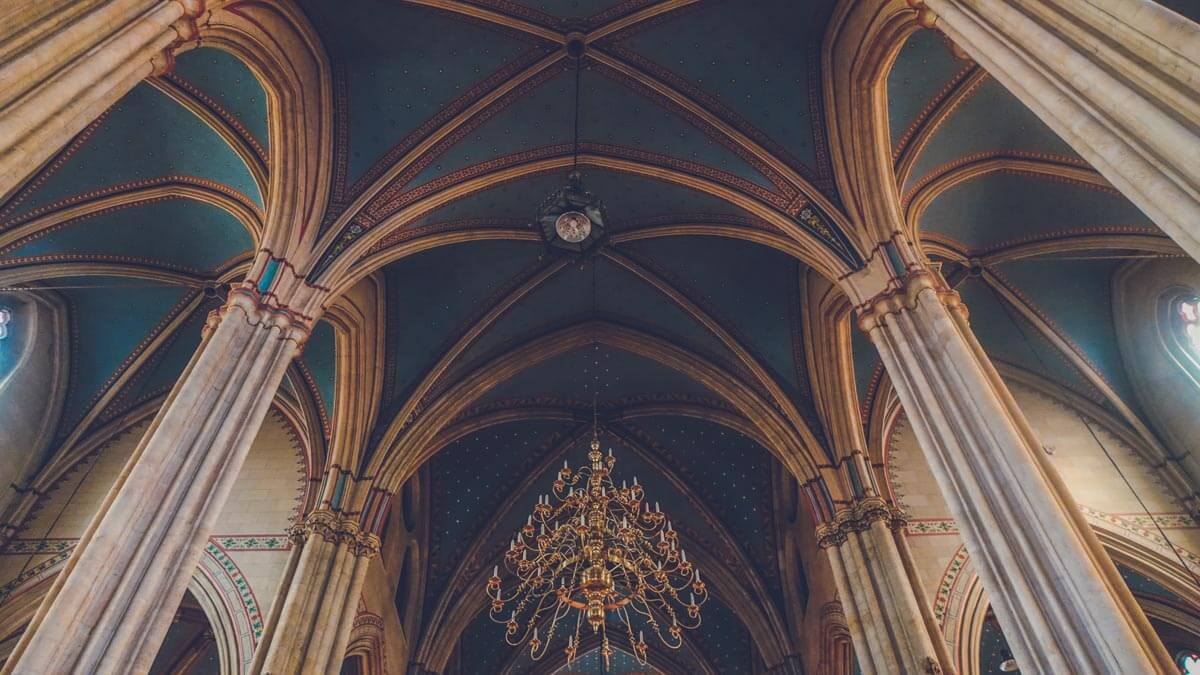
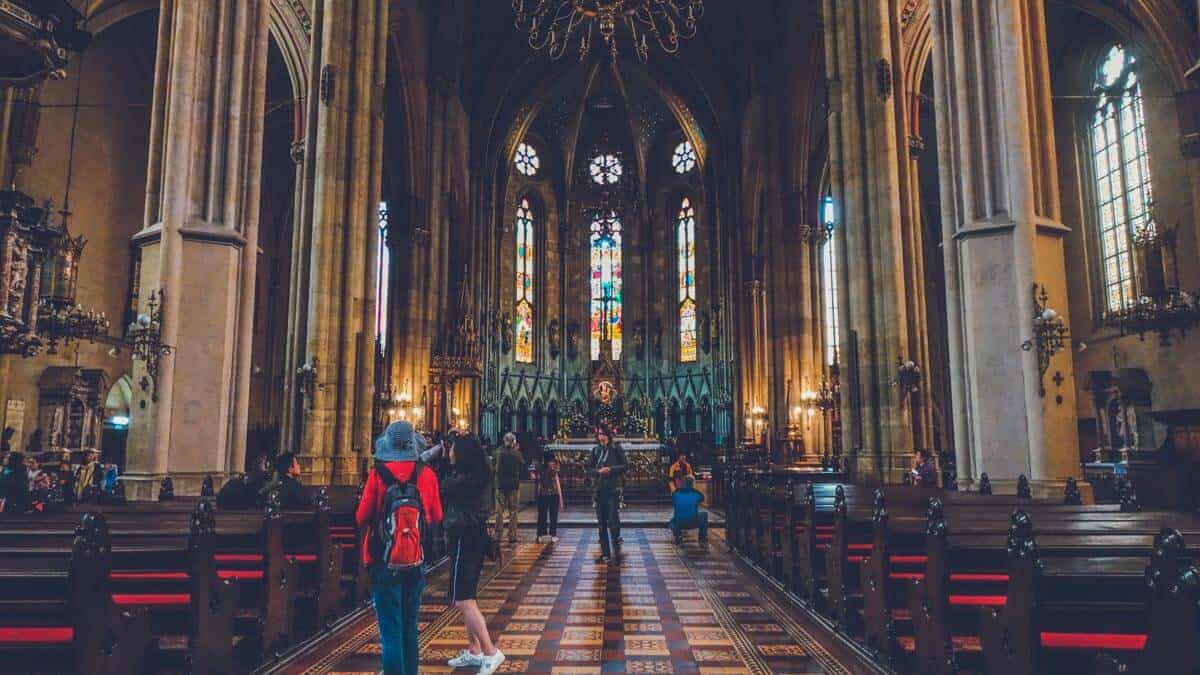
In front of the cathedral, you’ll see a fountain featuring Virgin Marry and four angel statues. The statues are gold-plated and the angel statues represent Christian virtues of Faith, Innocence, Hope, and Humility.
Buy fresh fruits at the Dolac Market
One of the things to do in Zagreb is to visit Dolac Market, an open-air food market in the center of the town. Being one of the most popular attractions of Zagreb, here you can not only buy fruits to snack on while you wander through the streets but also buy vegetables, meat and fish to prepare dinner. Besides, there are souvenir stalls as well.

However, if this is not your cup of tea and you are more of a culture buff, then there’s St. Mary’s Church you can visit.
Stroll down Zagreb’s most colorful street
Tkalciceva street used to house many workshops producing cloths, soap, liqueurs, and paper in the 18th century. However, at the end of the 19th century, it was transformed into a center of commercial activity and nightlife. Today, locals and tourists come here for small boutiques, traditional shops, cafes, and restaurants.
Pass through the Stone Gate

Stone Gate is the only old town gare that remains intact. Originally built in the Middle Ages, what you see today was a reconstruction done in the 18th century. There’s a chapel dedicated to the patron saint of Zagreb, Virgin Marry, under the arch.
What to do in Zagreb on a rainy day: visit the most unusual museum
If you read my blog, you might know that I am not a big museum fan. However, there are certain types I like, and the Museum of Broken Relationships is one of them, so it a perfect thing to do in Zagreb on a rainy day.
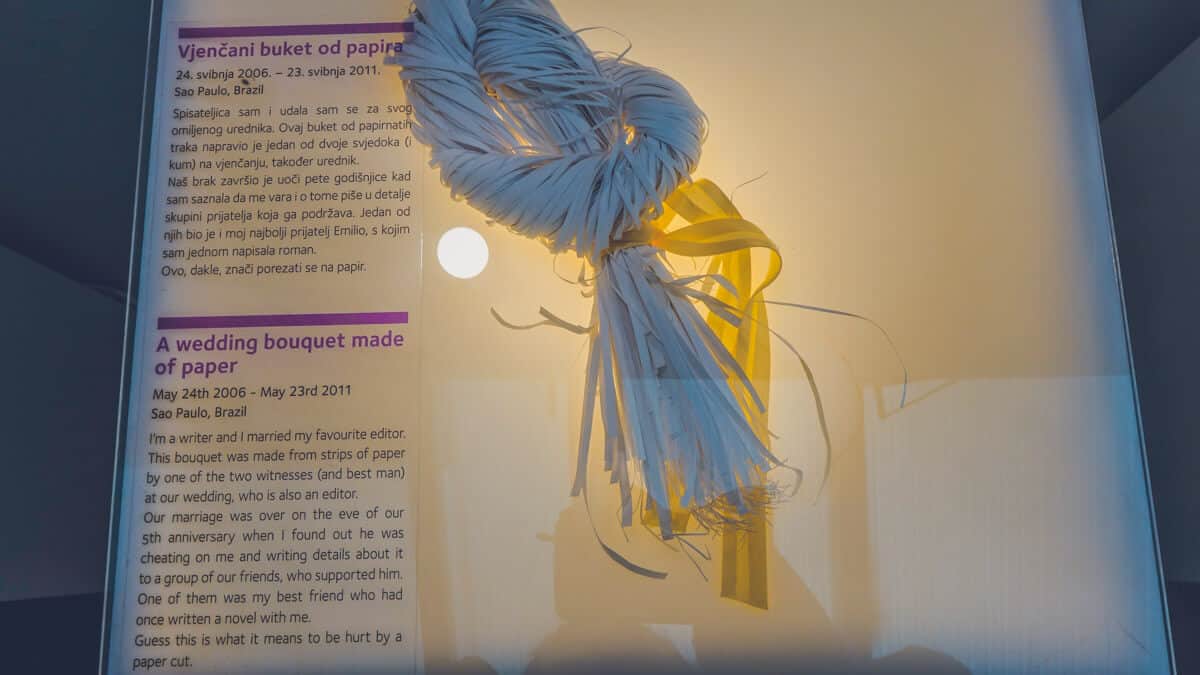
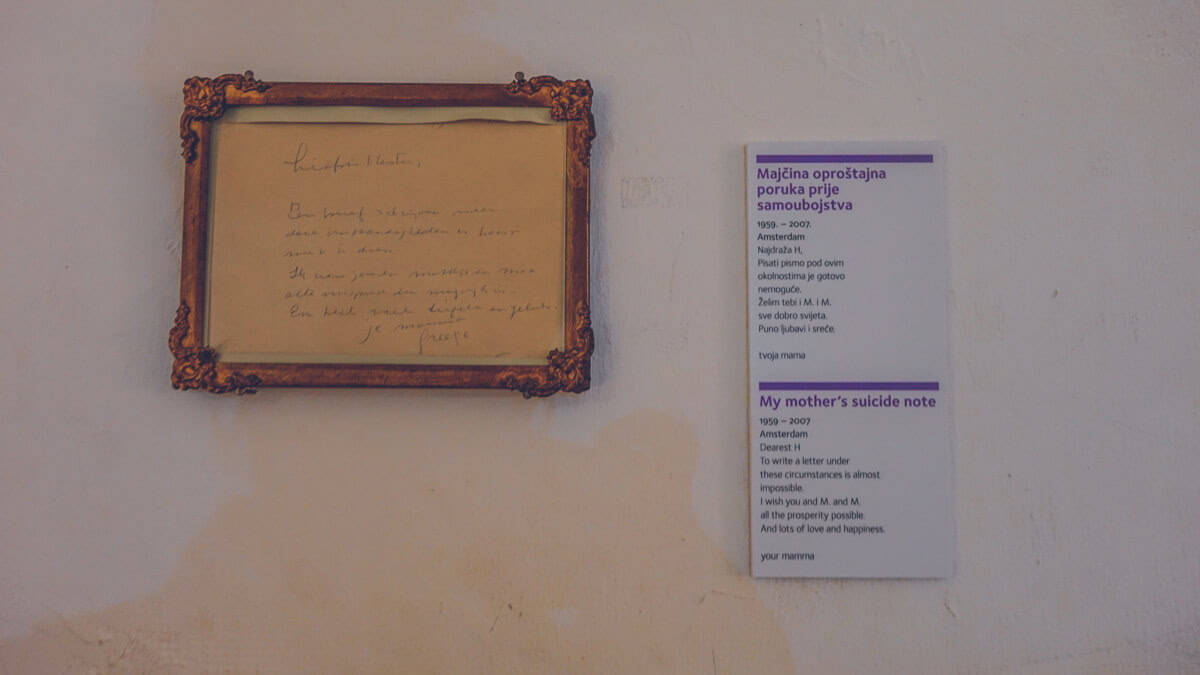
Being only two in the world, in Los Angeles and Zagreb, the museum is a global crowd-sourced project that exhibits items and memorabilia of many different broken relationships – be it with a loved one, friend or parents.
Every item displayed has its own story you can read, giving the visitors a mixed feeling as they go. For instance, I was laughing at one stand and crying on another.
- Entrance fee: 30 HRK
Admire the iconic symbol of Zagreb
If you’ve seen any pictures of Zagreb, you’ve seen the beautiful mosaic roof of St. Mark’s Church. The original church was built in the 13th-century church, while the gothic arched ceiling, sanctuary, and 15 statues were added a bit later.

The church was substantially rebuilt in the Neo-Gothic style at the end of the 19th century. The tiles on the roof show the coats of arms of the Triune Kingdom of Croatia, Dalmatia and Slovenia, and the city of Zagreb.
Ride the funicular

Other fun things to do in Zagreb include riding the funicular which is only 66-meter-long and connects Upper and Lower Towns. It’s the shortest passenger cable railway that takes only about 55 seconds to get from one end to another. Opened in 1890, the funicular operated on steam and was the first public transport used in the city.
- Entrance Fee: 4 HRK
Watch canon-firing
Lotrscak Tower is the only preserved medieval tower that dates back to the 13th century. Slightly modified six centuries later, the tower, today, is famous for canon fired every day at noon.
What to do in Zagreb in August: relax at one of the parks

After a long day of exploring and walking, it’s always a good idea to sit in greenery and enjoy your time. Zagreb has a fair share of green spaces and Zrinjevac park is one of the most favorable of them all. The park features plane trees, a wrought-iron bandstand, fountains, and busts of famous Croatian figures.
Look at the Meteorological Post

At one end of the Zrinjevac park, there’s a metrological post that records the city’s weather conditions since 1884. You can check the temperature, air pressure and coordinate your watch with a 24-hour dial.
King Tomislav Square
Tomislav was the first king of Croatia and the square dedicated to him is one of the busiest areas where you can sit down, enjoy a warm sunny day, and watch the life of locals.

The main railway station of the city is also located here. The first railway arrived in Zagreb in 1862 and connected the cultural center of Europe – Viena, and Budapest. The building was built in 1892 with Renaissance and Neoclassical elements. The whole area is one of the most beautiful places in the Lower Town.
My favorite travel Resources
✈ Book affordable flights on WayAway, a platform that shows the best flight deals, tours, and hotels. With a WayAway Plus membership, you can earn cashback. Get 10% off with code: RFD10
🚫 Get compensation for up to 700$ with Airhelp if your flight was canceled or delayed within the last 3 years.
🚗 Rent a car with DiscoverCars, a trusted international car rental website.
💻 Get a VPN from Surfshark to protect your devices from hackers when using public Wi-Fi when traveling.
📱 Install the Airalo app, which provides local eSIMs for a more affordable internet connection when traveling. Get 3 USD with code: BAIA2592.
💸 Use Wise to withdraw money in local currency without hidden fees and avoid high exchange rates. On top of that, you might get a Visa or Mastercard debit card.
🏨 Find budget-friendly deals on all sorts of accommodation types on Booking.com.
❣ Pre-book a private car transfer with Welcome Pickups to your hotel.
🩺 Buy the most flexible and budget-friendly travel insurance, SafetyWing, covering COVID with add-ons for adventure sports and electronics theft.
☀ Book in advance some of the best city walks, cultural experiences, and day tours to maximize your stay and experience here.
